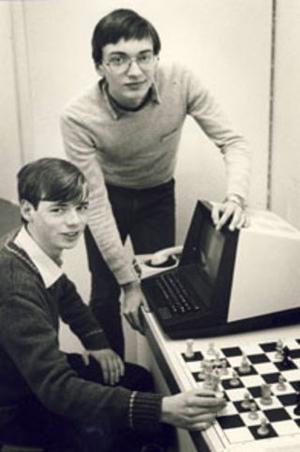Kai Himstedt

Kai Himstedt,
a German computer scientist and Ph.D. from the University of Hamburg on parallel game-tree search and Grid computing [2] [3]. Along with Ulf Lorenz, he is principle author of GridChess and Cluster Toga, cluster chess programs based on the open source chess programs Fruit by Fabien Letouzey, and the Fruit derivate Toga. GridChess is the doctorate of Kai Himstedt and a cooperation between the Paderborn University and the University of Hamburg. GridChess played the WCCC 2007, Cluster Toga the WCCC 2008 [4]. His further cluster chess projects GridProtector and GridGinkgo, playing the PT 49 in October 2015, and the WCCC 2016, incorporate Raimund Heid's Protector, and Frank Schneider's Ginkgo respectively.
Jugend forscht
As a teenager during the late 70s, Kai Himstedt already developed a chess program along with Wolfgang Stahn and participated at Jugend forscht, a German youth science competition, initiated in 1965 by Henri Nannen, then editor-in-chief of the Stern magazine. In 1980, they won the second prize in the mathematics and computer science section [6]:
Inspired by the chess computer boom and not impressed by the programs offered at the time, the two young friends developed their own computer chess program. As a comparison, the modern American chess program Chess 4.8 was available, in which the two young mathematicians discovered certain weaknesses.
By using the FORTRAN programming language and the TR 440 computer, the two young mathematicians set about developing their new program. The considerations for the development took about four weeks. Then in April 1979, first games could been played, but were unsatisfactory in the eyes of young researchers. Further improvements of the program made it possible that one of the best micro-computer chess prograns, the Chess Challenger 7 could be beaten.
Their program proved to be so good that even the computer chess world champion Chess 4.8 could be beaten when using a suitable computer. A special feature of the new program is that an exchange of pieces with its effects on the overall course of the game was not completely calculated by search, but evaluated statically, yielding in a considerable shortening of the processing time.
See also
Selected Publications
- Kai Himstedt (1993). Verfahren zur Vermeidung redundanter Übersetzungen in modularen Softwaresystemen. Diplomarbeit im Fach Informatik, Universität Hamburg, Hamburg. (German)
- Kai Himstedt (2005). An Optimistic Pondering Approach for Asynchronous Distributed Games. ICGA Journal, Vol. 28, No. 2
- Kai Himstedt, Ulf Lorenz, Dietmar P. F. Möller (2008). A Twofold Distributed Game-Tree Search Approach Using Interconnected Clusters. Euro-Par 2008: 587-598
- Kai Himstedt (2012). Optimistische verteilte Spielbaumsuche am Beispiel des Computerschachs. Dissertation (German) [9]
- Kai Himstedt (2012). GridChess: Combining Optimistic Pondering with the Young Brothers Wait Concept. ICGA Journal, Vol. 35, No. 2
External Links
- Kai Himstedt's ICGA Tournaments
- Jugend forscht 1980 | Mathematik/Informatik | Die Entwicklung eines Schachprogramms als Beispiel für eine spezielle Form der künstlichen Intelligenz (German)
- PhD Project of Kai Himstedt (Dipl.-Inform.)
References
- ↑ Mit "Jonny" muss gerechnet werden June 19, 2007, Schachclub Forchheim
- ↑ PhD Project of Kai Himstedt (Dipl.-Inform.)
- ↑ Kai Himstedt (2012). Optimistische verteilte Spielbaumsuche am Beispiel des Computerschachs. Dissertation (German)
- ↑ Kai Himstedt's ICGA Tournaments
- ↑ Jugend forscht 1980 | Mathematik/Informatik | Die Entwicklung eines Schachprogramms als Beispiel für eine spezielle Form der künstlichen Intelligenz
- ↑ Jugend forscht 1980 | Mathematik/Informatik | Die Entwicklung eines Schachprogramms als Beispiel für eine spezielle Form der künstlichen Intelligenz (German), translated with the help of Google Translate
- ↑ ICGA Reference Database
- ↑ DBLP: Kai Himstedt
- ↑ Dap Hartmann (2013). Optimistically Parallelizing Parallel Search Processes. ICGA Journal, Vol. 36, No. 2, Review
